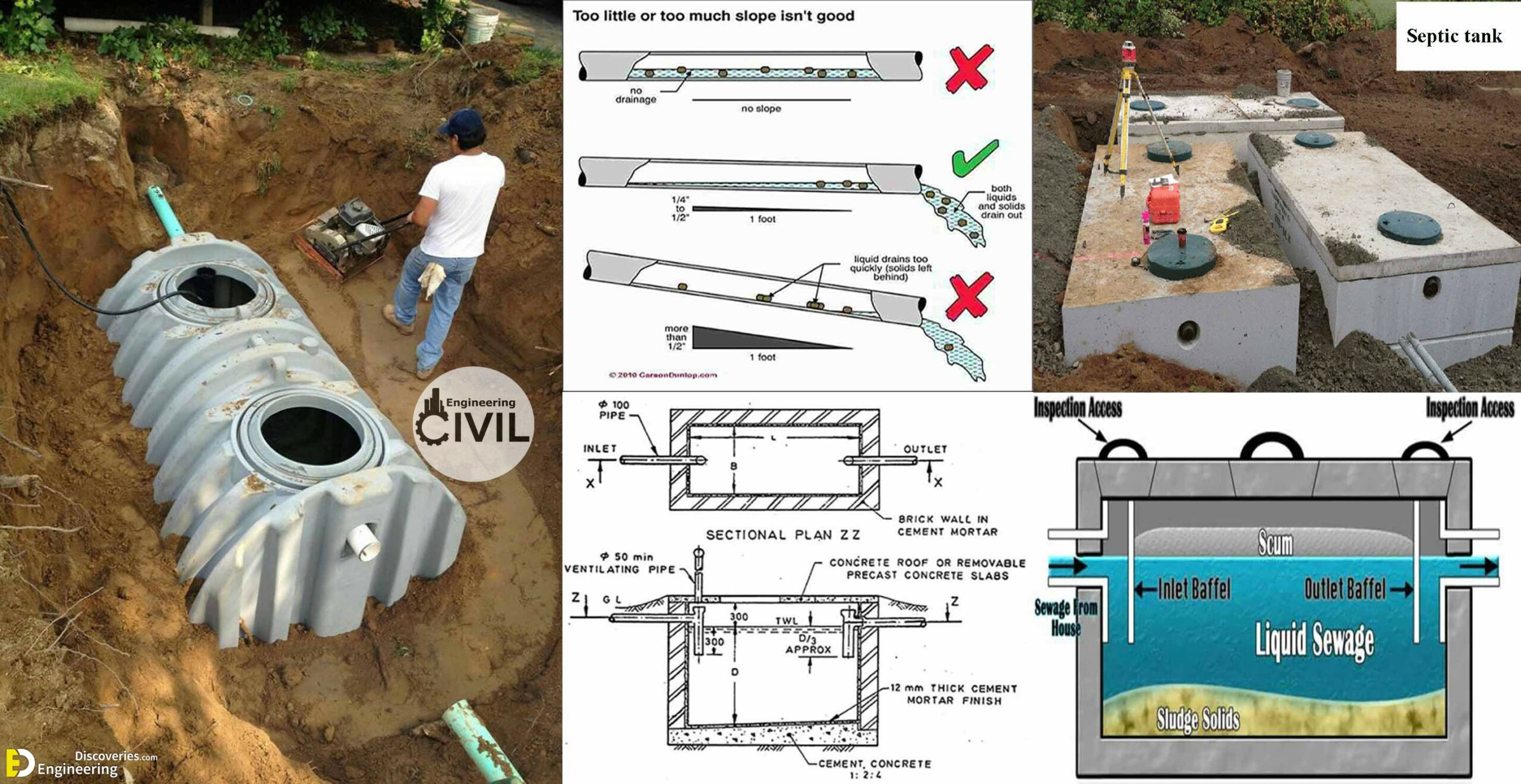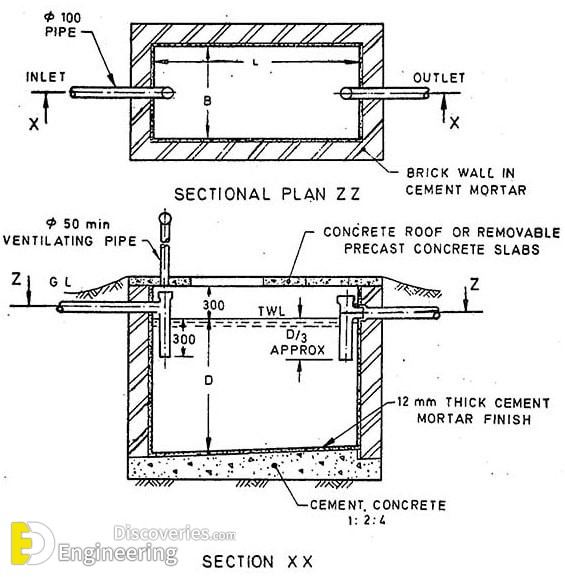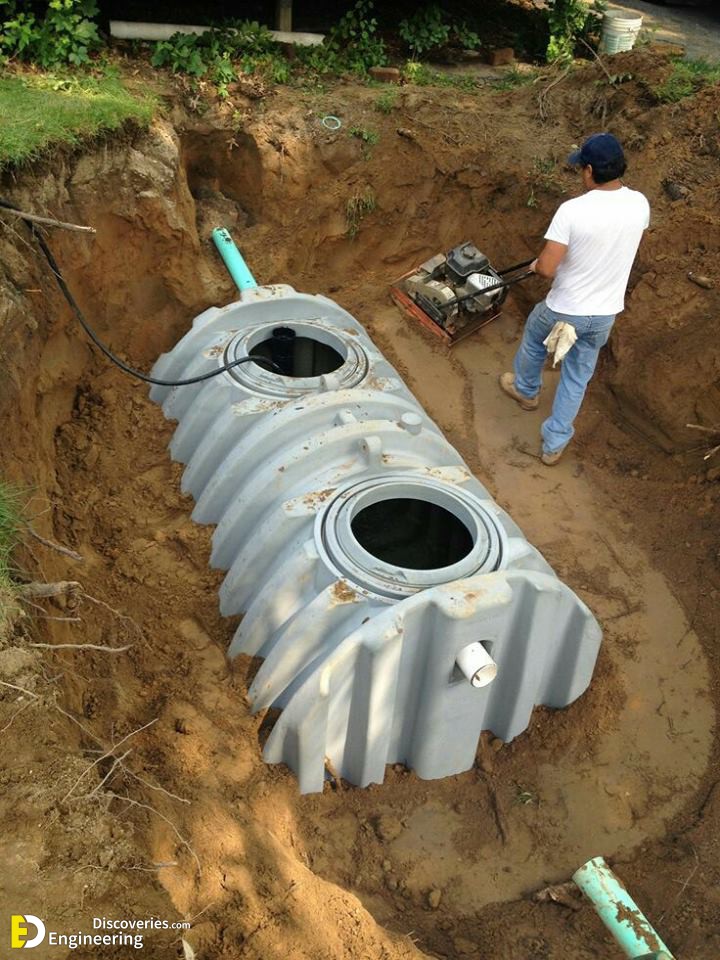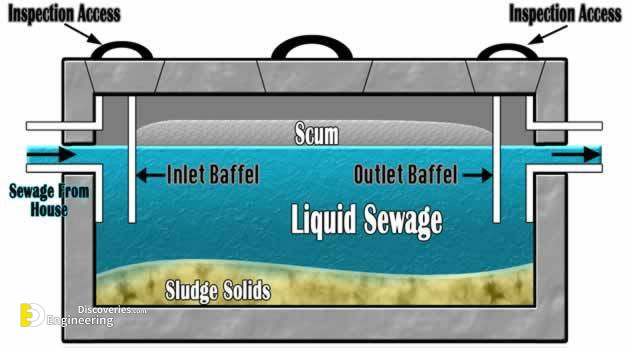What is a Septic tank?
A septic tank is an underground chamber made of concrete, fiberglass or plastic through which domestic wastewater (sewage) flows for basic treatment. Settling and anaerobic processes reduce solids and organics, but the treatment efficiency is only moderate (referred to as “primary treatment”). Septic tank systems are a type of simple onsite sewage facility (OSSF). They can be used in areas that are not connected to a sewerage system, such as rural areas. The treated liquid effluent is commonly disposed of in a septic drain field which provides further treatment. However, groundwater pollution may occur and can be a problem.
The term “septic” refers to the anaerobic bacterial environment that develops in the tank which decomposes or mineralizes the waste discharged into the tank. Septic tanks can be coupled with other onsite wastewater treatment units such as biofilters or aerobic systems involving artificially forced aeration. The rate of accumulation of sludge—also called septage or fecal sludge—is faster than the rate of decomposition. Therefore, the accumulated fecal sludge must be periodically removed which is commonly done with a vacuum truck.
Design of Septic Tank
The capacity of the septic tank depends on the number of users and the interval of sludge removal. Normally sludge should be removed every 2 years. The liquid capacity of the tank is taken as 130 liters to 70 liters per head. For a small number of users 130ltr per head is taken. A septic tank is usually provided with a brick wall in which cement mortar [not less than 20 cm (9 inches)] thick and the foundation floor is of cement concrete 1:2:4. Both inside and outside faces of the wall and top of the floor are plastered with a minimum thickness of 12 mm (one-half inch) thick cement mortar 1:3 mix.
All inside corners of the septic tank are rounded. Waterproofing agent such as Impermo, Cem-seal or Accoproof, etc. is added to the mortar at the rate of 2% of the cement weight. The waterproofing agent is to be added in a similar proportion to the concrete also for making the floor of the tank. For proper convenience in the collection and removal of the sludge, the floor of the septic tank is given a slope of 1:10 to 1:20 towards the inlet side. This means that floor of the outlet side will be on a higher elevation than the floor on the inlet side.
Dimensions of Septic Tank Components
1- Length, Width and Depth of Septic Tank
Width = 750 mm(min)
Length = 2 to 4 times width
Depth = 1000 to 1300 mm. (min below water level) + 300 to 450 mm free board
Maximum depth = 1800 mm + 450 mm free board
Capacity = 1 cubic meter (10 cubic feet) minimum
2- Detention period
Detention period of 24 hrs (mostly) considered in septic tank design. The rate of flow of effluent must be equal to the rate of flow of influent.
3- Inlet and outlet pipes
An elbow or T pipe of 100 mm diameter is submerged to a depth of 250-600 mm below the liquid level. For outlet pipe, an elbow or T type of 100 mm diameter pipe is submerged to a depth of 200-500 mm below the liquid level. Pipes may be of stoneware or asbestos.
4- Baffle Walls of Septic Tank
For small tanks, RCC hanging type scum baffle walls are provided in septic tanks. Baffle walls are provided near the inlet. It is optional near the outlet.
The inlet baffle wall is placed at a distance of L/5 from the wall, where L is the length of the wall. The baffle wall is generally extended 150 mm above the scum level and 400-700 mm below it. Scum being light generally floats at the water level in the tank. The thickness of the wall varies from 50 mm to 100 mm. for large tanks lower portion are having holes for the flow of sludge.
5- Roofing Slab of Septic Tank
The top of the septic tank is covered with an RCC slab of the thickness of 75-100 mm depending upon the size of the tank. Circular manholes of 500 mm clear diameter are provided for inspection and desludging. In the case of rectangular opening clear size is kept as 600 X 450 mm.
6- Ventilation Pipe
For outlet of foul gases and ventilation purpose cast iron or asbestos pipe of 50-100 mm diameter is provided which should extend 2 m (min) above ground level. The top of the ventilation pipe is provided with a mosquito-proof wire mess or cowl.
Example – Design of Septic Tank for 20 Users
Liquid capacity of the tank:
@120 lts per user = 0.12 X 20 =2.4 cum
Take liquid depth as 1.3 meter.
Therefore Floor area of the tank = 2.4/1.3 = 1.85 m2
Taking length as 2.5 times the breath
L X B=1.85
2.5 B X B = 1.85
B = Sqrt (1.85/2.5) = 0.86 say 0.9 m
Therefore, the dimension of the tank is 22.5 X 0.9 m
Suitable Sizes of Septic Tank Based on Number of Persons
| No of users | Length L in m | Breath B in m | Liquid Depth in m | Liquid Capacity to be provided in m3 | Free Board in m | Sludge to be removed(m3) | Interval Cleaning |
| 5 | 1.5 | 0.75 | 1.01.05 | 1.121.18 | 0.30.3 | 0.360.72 | 1 year2 year |
| 10 | 2.0 | 0.9 | 1.01.4 | 1.82.0 | 0.30.3 | 0.721.44 | 1 year2 year |
| 15 | 2.0 | 0.9 | 1.32.0 | 2.33.6 | 0.30.3 | 1.082.16 | 1 year2 year |
| 20 | 2.3 | 1.1 | 1.31.8 | 3.34.6 | 0.30.3 | 1.442.88 | 1 year2 year |
| 50 | 4.0 | 1.4 | 1.32.0 | 7.311.2 | 0.30.3 | 3.607.20 | 1 year2 year |



















